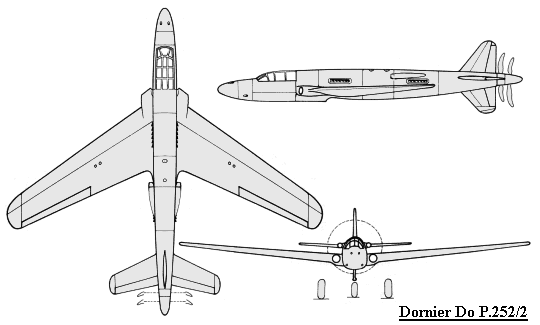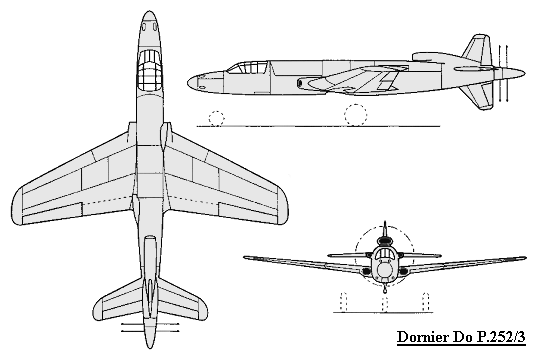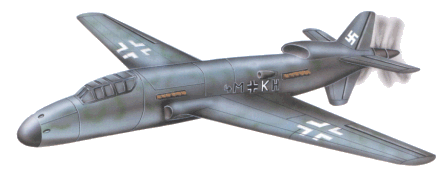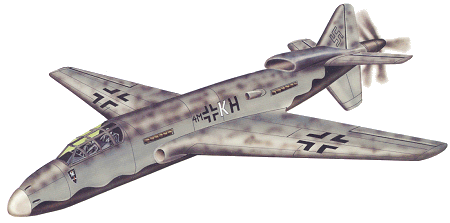 The Dornier Do P.252 was designed in 1943, but was later to be submitted
for the optimum Luftwaffe night fighter contract specification from January
27, 1945. Three studies (P.252/1, /2 and /3) were made from this design,
all were similar despite their slightly different dimensions and wing plan
forms.
The Dornier Do P.252 was designed in 1943, but was later to be submitted
for the optimum Luftwaffe night fighter contract specification from January
27, 1945. Three studies (P.252/1, /2 and /3) were made from this design,
all were similar despite their slightly different dimensions and wing plan
forms.
The P.252/3 had a lengthy fuselage, with room for a three man crew. The wings were swept back at 22.5 degrees and featured dihedral. There were two Junkers Jumo 213J liquid-cooled 12 cylinder engines (1750 horsepower for takeoff each) with MW 50 boost, which were tandem coupled to an extension shat that drove two 3.2 meter (10' 6") contra-rotating three bladed propellers that featured a blade sweep of 50 degrees. The front engine was fed by round air intakes located in the wing roots and
 on
the starboard side of the fuselage, the rear engine was fed by an air intake
located on the port side of the fuselage; there was also a large air intake
on top of the rear fuselage just forward of the cruciform tail unit. One
advantage of this tail design was that the bottom fin also served as a
tail bumper to keep the propellers from hitting the ground on takeoff.
The landing gear was of a tricycle configuration, with the main gear retracting
inwards into the fuselage and the nose gear retracting to the rear. A three
man crew sat in the cockpit located in the forward fuselage, with the pilot
and radar operator sitting back-to-back on the left, while the navigator
sat facing the front and to the right of the pilot and radar operator.
The P.252 had a formidable armament (please see the
table below), and there was an internal radar dish inside the interchangeable
nose section.
on
the starboard side of the fuselage, the rear engine was fed by an air intake
located on the port side of the fuselage; there was also a large air intake
on top of the rear fuselage just forward of the cruciform tail unit. One
advantage of this tail design was that the bottom fin also served as a
tail bumper to keep the propellers from hitting the ground on takeoff.
The landing gear was of a tricycle configuration, with the main gear retracting
inwards into the fuselage and the nose gear retracting to the rear. A three
man crew sat in the cockpit located in the forward fuselage, with the pilot
and radar operator sitting back-to-back on the left, while the navigator
sat facing the front and to the right of the pilot and radar operator.
The P.252 had a formidable armament (please see the
table below), and there was an internal radar dish inside the interchangeable
nose section.
Although there were definite advantages to this design, such as excellent visibility (due to the fact that the engines and propellers were in the rear), heavy armament and good endurance (approximately four hours), the official specification was only for aircraft to be powered by turbojets. So, the Do P.252 design was abandoned reluctantly.



